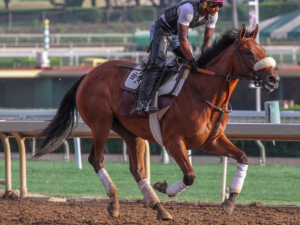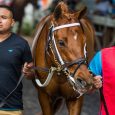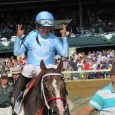By Ray Wallin
Triangles are a part of our everyday life. If you have ever been hustled playing pool, your crafty opponent was racking up the balls in one before he took your cash.

Bellafina – US Racing Photo
The triangle was the only instrument your elementary band teacher trusted you to play.
Triangles are an important part of structural design, you see them in bridge trusses all the time. You know not to take the flight through the Bermuda Triangle, just in case. Some people are caught in a nasty love triangle.
With all these triangles, there is one that was engrained in your head at an early age, the fire triangle. I am sure you remember this from your elementary school days. In order for a fire to ignite, it needs three things: heat, fuel, and oxygen.
As they reminded me on my first day of the Fire Academy, if you take away one of the sides of the fire triangle, the fire will fail to ignite.
Right now you are thinking how the heck is Mr. Wizard’s fire lesson related to a horseplayer. The answer is that to be a winning horseplayer, like those that make their living playing the races, you need to make sure that you complete all three sides of the Winning Horseplayer Triangle.
Similar to the fire triangle, the Winning Horseplayer Triangle has three sides that all must be present for a consistent, long-term profit to happen. The three sides are money, handicapping, and strategy. If you remove even one side of the Winning Horseplayer Triangle, you are headed down a path of losing.
Money
This is pretty obvious. You need money to make money. If you don’t have a bankroll to bet with, it doesn’t matter how good your handicapping or bet strategy is, you having nothing to wager on the races. Likewise, you could be Bill Gates rich and again, if you can’t handicap or strategize a bet to save your life, you will be broke before you know it.
Like the Peter Parker principle of Spiderman fame that says “With great power comes great responsibility,” with your bankroll comes great responsibility, too. You need a proven money management system in place. No one wants to be like Bombs Away Billy.
You know this guy. He walks into the track or OTB and drops a ton of money on the first race. Shortly after the horses cross the finish line he is making the walk of shame back to his car, hoping he has enough gas to get home.
Money management is not a one size fits all approach. What works for me or worked for my late Uncle Dutch probably won’t work for you. Only you can determine your strengths and weaknesses based on a thorough review of your own wagering and approach.
It may be a fixed amount based on the criteria your contenders meet or a percentage of your bankroll. Regardless, you need to do some homework to figure out what bets, angles, or criteria make you a winner.
Handicapping
It goes without saying that if you can’t pick winning horses or contenders, you’re never going to cash a ticket. You could have a huge bankroll and know how to right size your bets, but if you don’t pick the winning horses you aren’t going to make a profit.
If your handicapping isn’t good, you need to assess what is or isn’t working and use that to your advantage. Not every angle I have developed or tracked has been a winner. Sometimes knowing what doesn’t work is as powerful as knowing what works.
I have found that first time geldings underperform as a group, winning a mere 8.82 per cent of the time with an expected win rate of closer to 16 per cent. Not that you can totally discount these horses, but I wouldn’t key one in your Pick 4.
There are steps you can take to improve your handicapping. Some you may already be doing, some you may want to focus on. Regardless, take a deep dive into your approach and find your best opportunities to select winning contenders.
Strategy
Two summers ago I was spending a lazy August Friday afternoon at Monmouth Park. All of the usual suspects were there. I settled into my usual spot in the paddock to watch the post parade with Rail Guy talking my ear off. “I got a lead on dat hoss in da eighth race from dat guy,” he emphatically stated as the horses were starting to get saddled. I tried to drown him out, but his reinforcements arrived.
It was like watching the movie ‘Twins’ with Danny DeVito and Arnold Schwarzenegger. Sure Thing Sammie was tall and thin, but as mangy and disheveled as Rail Guy. After a quick introduction, Rail Guy proceeded to tell me how Sammie was going to “crush dat late Pick 4.” Since I play most of my bets horizontally I decided to engage with Sammie. He mapped out to me how he constructed his Pick 4, which Rail Guy continued interrupting us to remind me that it was a lock.
Sammie was going to play a Pick 4 with 96 combinations (4x3x2x4). Unfortunately they asked my opinion, but I am not good at sugar-coating things. I remarked that the ticket had a good chance to win since Sammie and I had landed on several of the same contenders, yet I questioned if the payout would cover the cost of the ticket.
Rail Guy scoffed at me and added “ya know da late Pick 4 always pays good, right?” While the previous weekend saw some hefty payouts, today was a different story. There were a lot of strong favorites running late in the card, in fact in three of races I locked in on the favorite. “I guess we’ll see,” I said before I wished them luck and headed off down to my spot on the rail.
Sure Thing Sammie crushed that Pick 4, yet for his wager of $48 (playing it for $.50) he returned $28. The chalk won all four legs of the late Pick 4. Neither Rail Guy nor Sure Thing Sammie brought it up when I saw them later, but they learned a lesson that day.
You can have a big bankroll and be a great handicapper, but if you can’t strategize and plan your bets you aren’t going to win any money. You need to weigh the risks and likelihood of favorites winning against how deep you plan to go on your horizontal and vertical wagers. You don’t want to play to break dead even or lose money when winning like our friend Sure Thing Sammie.
Like money management, there is no one size fits all solution. You need to do a deep dive on the types of wagers you place and how well your contenders do in those types of wagers. You also need to be mindful of the morning lines of the horses you assemble into horizontal wagers. If you are leaning towards all low priced horses your wager needs to be smaller than if you feel strongly about horses with higher odds.
Remember that it takes all three sides of the triangle – money, handicapping, and strategy to be a consistent winner at the track in the long-term. If you find a weakness in any one of those three sides, work on it until it is stronger and you will have all the ingredients you need to profit playing the races.
If you enjoyed this piece, check out other articles at our horse racing news section!



